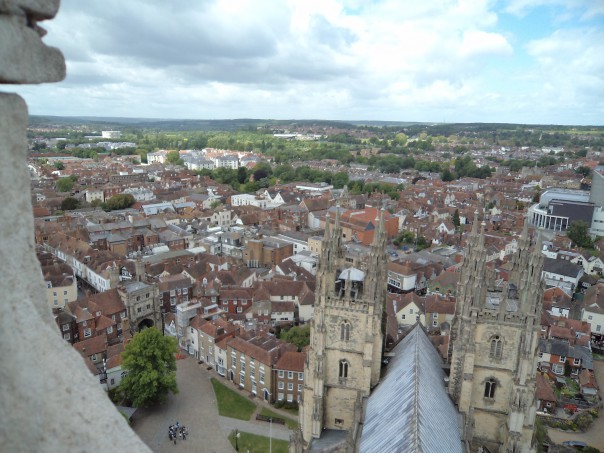This week I am going to use the blog spot to give you Rob Gainey’s response to the recent ‘New Directions in Kent History’ conference because as a current Christ Church postgraduate working on a Kent topic he can, like his fellow postgraduates, be seen as one of Joan Thirsk’s academic great-grandchildren. Rob is researching the history of Eastbridge Hospital in early modern Canterbury and if you look very carefully at the photo above you will catch a glimpse of the hospital. So over to Rob:
Postgraduate view on the health of history from below in and on Kent – Thirsk conference
The history of Kent is a long and deep story – a microcosm per se of England’s. This was the message that seems to have come through strongest at the conference honouring and continuing the work of the late Joan Thirsk. The speakers that addressed the academic community there present shared knowledge of historical research that had been either understudied or was only just beginning in its discovery.
Another view from Bell Harry
For those of you who know Canterbury, Eastbridge Hospital is almost at the centre of this photo
The curiosity and investment of the historians towards Kent is indisputably evident. The county’s motto is Invicta, unconquerable, and it is clear that this spirit of determination once held by the citizens of the county a millennium ago has emerged itself once more in establishing Kent’s background and development. Few stones have remained unturned, whilst there was excitement of areas of study that have not yet truly been touched upon but the mere essence addressed in preparation to be taken further. With confidence, it can be claimed that Thirsk would be both enthused and pleased by the development of study that has since taken place.
The diversity, both in range and time period, has helped reveal how rich Kent is in what it has to tell. As a postgraduate, this encourages the idea that there can be the ability to later continue such work and be a part of what is very clearly a lively academic setting. The thing that is so clearly wonderful about history from below is that it is not restrained. In many ways this has allowed the capability to uncover areas that would otherwise not have been so well studied. Through this, it continues to paint a broader representation of Kentish history.
From tithing to deer parks, we were able to see the valuable role that the county has played and continues to play in this country. The importance of it in a religious setting, so often known due to the central prominence of the city of Canterbury, was in some ways overshadowed by its political significance and architectural beauty. Through this, it has allowed a new breath of life to come into this area of study as it has lifted restrictions that felt as if they were formerly present.
Certainly, to those of us in attendance who are advancing in academia, it gave us the drive and interest to further pursue Kent. Often it feels as though most of the history has already been written or uncovered, yet this conference revealed to us just how rich the life of the history of this county is. The times when the speaker would state that ‘this needs further study’ or ‘there is much more to research into on this topic’, has invigorated this postgraduate community to be eager to continue through with the work that has only just started.
The history of Kent, then, is fascinating and anyone in attendance would be unable to dispute this statement. What is more fascinating however, is the focus and drive to continue to fill in the pieces of the jigsaw that is this historical story.
It is always encouraging for anyone in an academic setting to see people passionate about what they are researching into. Fortunately this is what was witnessed at this conference. Questions were asked not just to be said but in a genuine curiosity to further understand the whole picture. History from below in Kent is exciting because those who study it are excited about it – and this was only too apparent.
Thus there is no fear that the study of history within Kent is suffering. It is evident that there is a clear wish to pursue what has not been pursued and discover the so far undiscovered. Kent holds stories and importance that people are only too keen to learn about. The significance of this conference is that it helped to show just how much academics and those merely interested in history, wished to spread the picture of this county. Furthermore, from what was being spoken, it is clear that there should be no fear for the history on Kent as there is so much left to be studied, and much historiography to be discussed. As a postgraduate, this is incredibly important as it encourages the later study of a county that has become personally significant, of which there will be invested interest – a reflection as to why those speaking on it were equally so passionate. History from below on and in Kent is therefore something that is contributing encouragingly to the national picture. The whole conference exceeded expectation, and revealed that those speaking on Kent and the history of the county have a future that is rich, diverse, and living.
 Centre for Kent History and Heritage
Centre for Kent History and Heritage Sheila Sweetinburgh
Sheila Sweetinburgh 498
498


